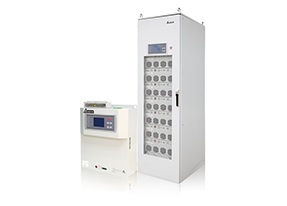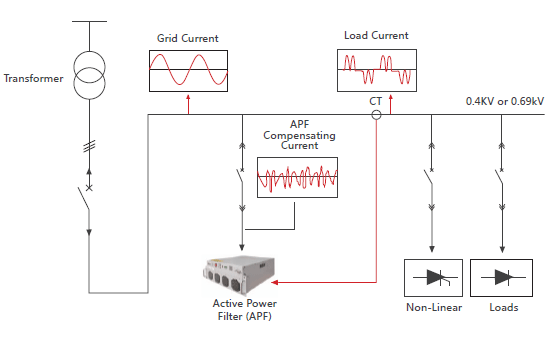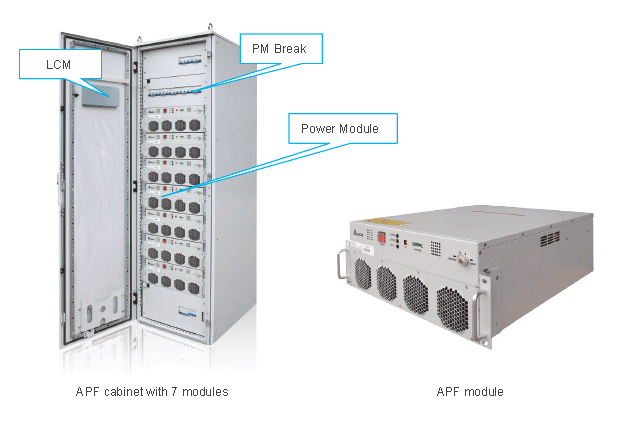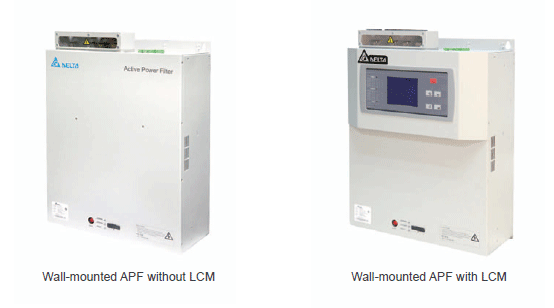 APF Principle
APF Principle
Delta’s PQC Series APF is connected in parallel with non-linear loads, and uses one set of current transformers (CT) to detect the load current. It calculates each order harmonic current by FFT algorithms in its DSP microchips, and then generates a compensating current with the same amplitude but opposite phase angles to the detected harmonic current, which cancels out the original load harmonics.
The PQC series APF not only eliminates harmonic current from the load side, but it also mitigates harmonic voltage caused by harmonic currents. The APF system can also improve power factor (PF) and correct load imbalances in the power system.

APF Structure
Delta PQC Series APF has a modular design. Usually the Delta active power filter system consists of one or several APF modules and an optional Liquid Crystal Monitor & Control Panel (LCM). Each APF module is an independent harmonic filtering system, and users can change the harmonic filtering system rating by adding or removing APF modules.
According to the mounting type, Delta PQC series APF can be divided into Modular APF and Wall-mounted APF.
Modular APF
APF modules and an LCM panel can be embedded in Delta’s standard APF cabinet or a customized cabinet. There are breakers, cable terminals and Surge Protection Device (SPD) in the APF cabinet.
According to cable terminal type, a modular APF can be divided into two types:
- Draw type modular APF (hot-swappable)
- Fixed type modular APF (not hot-swappable)

Wall-mounted APF
Delta’s Wall-mounted APF can be installed on a wall, which is suitable for low rating applications, and an optional LCM
panel can be fixed on the all-mounted APF according to customer requirements.

- Multifunctional: Harmonic, reactive power and imbalance compensation
- High harmonic filtering rate: Up to 98%
- Excellent reactive compensation: High speed, Precise (-0.99≤PF≤0.99), Step-less, Bi-directional (capacitive and inductance) compensation
- Excellent imbalance correction: Both negative and zero sequence, mitigates neutral current
- Wide input voltage & frequency range, adapts to tough electrical environments
- Low thermal loss (≤3% of rated APF kVA), efficiency ≥ 97%
- High stability: Infinite impedance to grid, avoids harmonic resonance problems
- Flexible application: Modular design, embedded in standard or customized cabinet
- Easy installation and maintenance: Plug-in installation for APF module replacement and expansion
- Wide capacity range: 50A~525A for a single cabinet, up 10 cabinets in parallel
- Environmental adaptability: -10~50°C temperature, compatible with diesel generator
- Complete protection: Grid Over/Under voltage, APF over current, over temperature, and more. All faults are recorded in the event log, which is convenient for failure analysis
Specifications
Rated Voltage : AC 400V, AC 690V
Electrical Specification
Input Voltage Range
AC 400V : AC 308V~480V
AC 690V : AC 432V~880V
Electric Connection
AC 400V : 3P3W/3P4W
AC 690V : 3P3W
Rated Frequency : 50Hz (60Hz) +/- 10%
Input Voltage THD Range : ≤15%
Rated Current per Module
AC 400V : 50Amp, 75Amp, 100Amp
AC 690V : 100Amp
Rated Current per Cabinet
AC 400V : 50~525Amp (module combination)
AC 690V : 100~500Amp (module combination)
Redundancy : Each module is an independent filtering system
Harmonic Elimination Range
AC 400V : 2rd ~ 50th order (Selectable)
AC 690V : 2rd ~ 31st order (Selectable)
Harmonic Filtering Degree
0 ~ 100% programmable per harmonic in Ampere value
Harmonic Filtering Performance
Filter up to 98% harmonics at rated load, THDv<3%, THDi<5% after filtering
Reactive Power Compensation Capability
Both inductive and capacitive reactive power
Reactive Power Compensation Performance
PF≥0.99 after compensation (if the APF capacity is sufficient)
Imbalance Correction Capability
AC 400V : Mitigate negative and zero sequence
AC 690V : Mitigate negative sequence
Full Response time : <20ms
Instant Response time : <100us Thermal Loss : ≤3% of APF rated capacity (kVA) Output Current Limitation : Automatic (100% rated capacity)
Parallel Expansion(System)
AC 400V : Up to 10 Racks(7 modules per cabinet)
AC 690V : Up to 10 Racks(5 modules per cabinet)
MTBF : >100,000 hours
Control Technology
Switching Frequency
AC 400V – 50A, 75A : 60kHz
AC 400V – 100A : 30kHz
AC 690A : 20kHz
Controller : DSP control
Communication : Modbus Protocol, RS232/485
Monitoring : PQC Monitor Software (Optional)
Physical Specification
IP Grade of Cabinet : IP20, IP30 or customization
Cooling method : Intelligent forced air cooling
Noise Level
AC 400V : < 65dB(A) @1m (Module)
AC 690V : < 70dB(A) @1m (Module)
Dust Filter : Optional
Dimension : Refer to APF Model table
Weight : Refer to APF Model table
Environmental Requirement
Ambient Temperature : -10~50 ℃
Relative Humidity : 0~95%
Altitude
≤ 1000m Rated Capacity,
1000-2000m (derating 1% per 100m)
All specifications are subject to change without prior notice.

